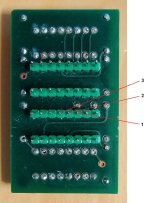HansTRS
Member
My TRS-80 Model I (manufactured in Japan) board has a piggyback board with code HEIIB006000 as shown in the photo. It contains 2 74LS157 chips, 7 resistors and 1 ceramic capacitor. Unfortunately I can't find any documentation about it. Can anyone tell me what this board is for?
The board has been sloppy soldered, points 1, 2 and 3 (image) do not appear to be connected to anything. Maybe point A should be connected to point 1, but I can't judge that.
I hope someone knows more about this and can help me.

The board has been sloppy soldered, points 1, 2 and 3 (image) do not appear to be connected to anything. Maybe point A should be connected to point 1, but I can't judge that.
I hope someone knows more about this and can help me.


